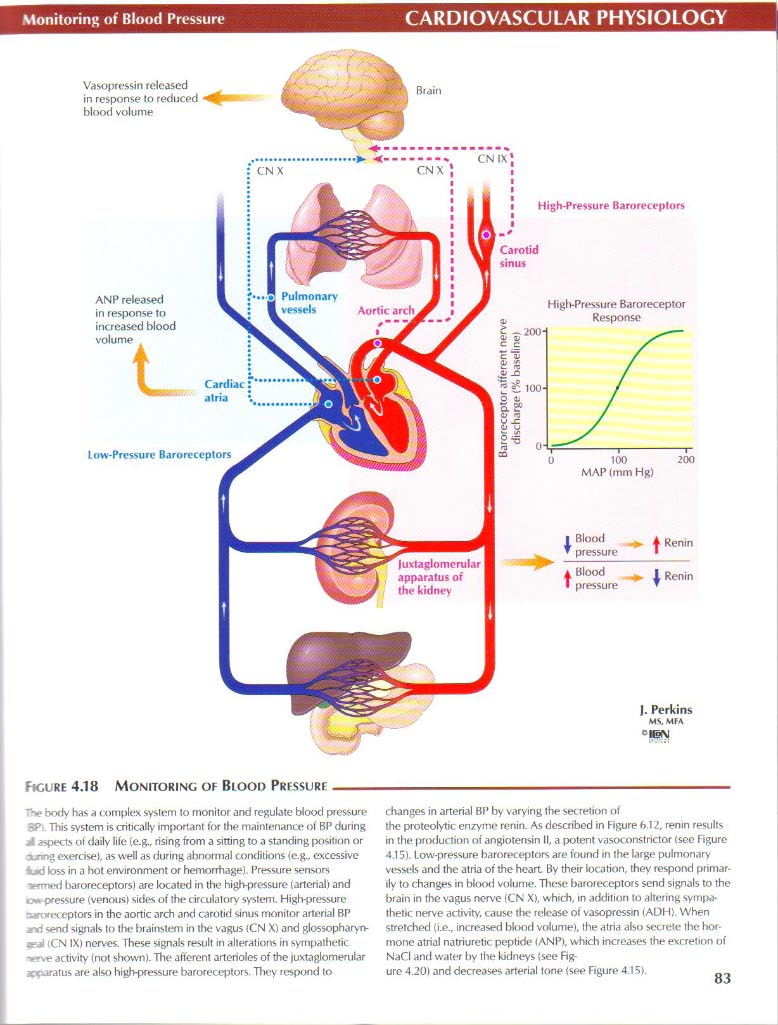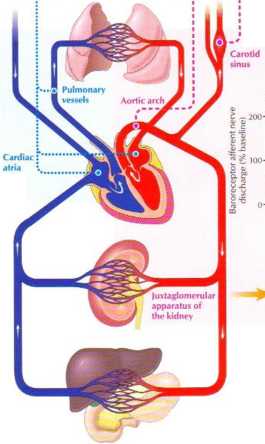netter70

Monitoring of Blond Pressure
CARDIOVASCULAR PHYSIOLOGY

Low-Pressure Baroreceptors
ANP released in response to increascd blood

High-Pressure Baroreceptors
Figurę 4.18 Monitoring of Biood Pressure-
The body bas a complex system to monitor and regulate blood pressure -P This system is critically important for the maintenance of BP during iI aspects ot daily life (c.g., rising from a sitting to a standing position or o-nng exerrise), as wefl as during abnomial conditions i e.g., excessive • uid lo$5 in a hot environment or hemorrhage). Pressure sensors -rmed baroreceptors) are located in the high-pressure (arterial) and . nn pressure (venous) sides of the circulatory system. High-pressure -ih eptors in the aortic arch orxt carotid sinus monitor arterial BP _ o send signab to lłxr brainstem in the vagus <CN X) and glossopharyn-iCN IX) nerves. These srgnals resiilt in alterations in sympathetic -*-rve activity (not shown). The afferent arterioles of the |uxtaglomerular Kparatus are also high-pressure baroreceptors. Tbey respond to
changos in arterial BP by varying the sec retion of the proteolytic enzyme renin. As describod in Figurę 6.12, remn results in the production ot angiotensin II, a potent vasoconstrictor <see Figurę 415). Low-pressure baroreceptors are tound in the large pulmonary vi*sds and the atria of the heart By their location, they respond primar-ily to changes in bkx>d volurne. These baroreceptors send signals to the brain in the vagus nonę (CN X), which, in addition to altering symi>a-tbetic nerve activity, cause the relcase of vasopressin (AUH). When stretched (i.e., increased blood volume), the atria also sccrete the hor monę atrial natriuretic peptide (ANP), which increases the excretion uf NaCI and water by the kidneys (see Figuro 4.20) and decreases arterial tonę (see Figurę 4.15). _
Wyszukiwarka
Podobne podstrony:
netter70 Monitoring of Blond PressureCARDIOVASCULAR PHYSIOLOGY Low-Pressure Baroreceptors ANP releas
netter161 Overview of Hormone ActionENDOCRINE PHYSIOLOGY Steroid Hnrmones Thyroid Hormones Vita
netter55 Slructure of the HeartCARDIOYASCULAR PHYSIOLOGY Mitral valve Poslerior cusp- Ascending aort
12897 netter104 Anatomy of Ihc Kidf»RENAL PHYSIOLOGY A. Antcrior surfacc of right kidney Superior ox
netter67 Control of Artcriolar TonęCARDIOVASCULAR PHYSIOLOGY Yasopressin (AI)H) J. Pcrkins MS, MfA I
netter84 tlechanics of Respiration: Surface ForcesRESPIRATORY PHYSIOLOGY Pressure (cm HjO) alveoli i
59840 netter71 CARDIOVASCULAR PHYSIOLOCY Short-Term Regulation of Blood Pressure 2/3t „NE Ganglion-
80805 netter84 tlechanics of Respiration: Surface ForcesRESPIRATORY PHYSIOLOGY Pressure (cm HjO) alv
netter84 tlechanics of Respiration: Surface ForcesRESPIRATORY PHYSIOLOGY Pressure (cm HjO) alveoli i
więcej podobnych podstron